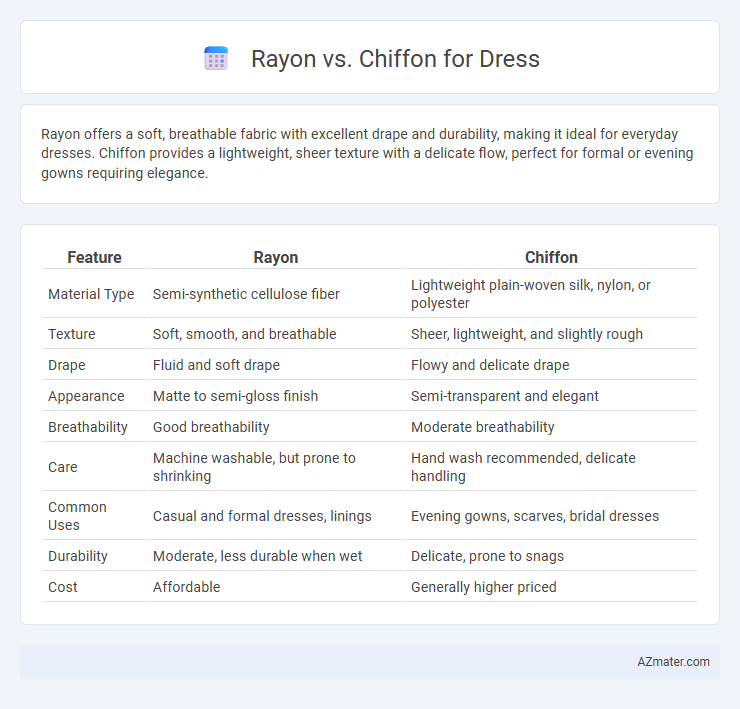Rayon offers a soft, breathable fabric with excellent drape and durability, making it ideal for everyday dresses. Chiffon provides a lightweight, sheer texture with a delicate flow, perfect for formal or evening gowns requiring elegance.
Table of Comparison
| Feature | Rayon | Chiffon |
|---|---|---|
| Material Type | Semi-synthetic cellulose fiber | Lightweight plain-woven silk, nylon, or polyester |
| Texture | Soft, smooth, and breathable | Sheer, lightweight, and slightly rough |
| Drape | Fluid and soft drape | Flowy and delicate drape |
| Appearance | Matte to semi-gloss finish | Semi-transparent and elegant |
| Breathability | Good breathability | Moderate breathability |
| Care | Machine washable, but prone to shrinking | Hand wash recommended, delicate handling |
| Common Uses | Casual and formal dresses, linings | Evening gowns, scarves, bridal dresses |
| Durability | Moderate, less durable when wet | Delicate, prone to snags |
| Cost | Affordable | Generally higher priced |
Introduction to Rayon and Chiffon
Rayon is a semi-synthetic fiber made from regenerated cellulose, known for its smooth texture, breathability, and affordability, making it ideal for lightweight dresses. Chiffon, a sheer fabric typically crafted from silk, polyester, or nylon, offers a delicate, flowing drape with a slightly rough texture that enhances elegance and movement in dress designs. Both materials are favored in fashion for their versatility and ability to create stylish, comfortable dresses suited for different occasions.
Fiber Origins: How Rayon and Chiffon Are Made
Rayon is a semi-synthetic fiber derived from regenerated cellulose obtained from wood pulp, making it a versatile fabric with a smooth texture and excellent breathability. Chiffon is traditionally a sheer fabric made from silk fibers but can also be crafted from synthetic materials like polyester or nylon, offering a lightweight, delicate drape. Understanding the fiber origins highlights rayon's plant-based cellulose foundation versus chiffon's reliance on natural silk or synthetic filaments, influencing their texture, durability, and care requirements in dressmaking.
Texture and Appearance Differences
Rayon features a smooth, soft texture with a subtle sheen, offering a more structured drape ideal for dresses that require a polished look. Chiffon is lightweight and sheer with a slightly rough texture, creating a flowing, ethereal appearance perfect for layered or evening gowns. The opaque quality of rayon contrasts with chiffon's transparency, affecting the dress's overall silhouette and formality.
Breathability and Comfort Comparison
Rayon offers excellent breathability due to its natural cellulose fibers, making it comfortable for warm weather wear. Chiffon, often made from silk or synthetic fibers, is lightweight and airy but can be less breathable than rayon, especially when crafted from polyester. For dresses, rayon generally provides superior comfort in hot climates, while chiffon excels in creating elegant, flowy silhouettes with moderate breathability.
Durability and Longevity: Which Lasts Longer?
Rayon and chiffon differ significantly in durability and longevity, with rayon typically offering greater strength due to its semi-synthetic fiber composition, which resists tearing and maintains shape better under regular wear. Chiffon, often made from silk or polyester, is delicate and prone to snagging and fraying, requiring careful handling and special laundering. For dresses intended for frequent use, rayon provides a longer-lasting fabric option, while chiffon suits occasional wear with its lightweight, sheer aesthetic.
Ease of Care and Maintenance
Rayon fabric requires gentle washing and air drying to prevent shrinking or damage, often needing ironing to maintain a smooth appearance. Chiffon, typically made from silk or synthetic fibers, is more delicate, necessitating hand washing or dry cleaning to preserve its lightweight texture and avoid fraying. Both fabrics demand careful handling, but chiffon generally involves higher maintenance due to its intricate weave and delicate nature.
Cost Comparison: Rayon vs Chiffon
Rayon offers a more budget-friendly option compared to chiffon, with prices typically ranging from $5 to $15 per yard, making it ideal for cost-conscious dressmakers. Chiffon, known for its sheer and delicate texture, usually ranges from $15 to $40 per yard, reflecting higher production costs and premium fabric quality. Choosing between rayon and chiffon depends on balancing fabric affordability with desired elegance and durability in dress design.
Best Uses in Dressmaking
Rayon offers a soft, breathable texture ideal for casual and summer dresses that require fluid drape and comfort. Chiffon provides a lightweight, sheer fabric perfect for elegant evening gowns and layered designs needing a delicate, airy appearance. Dressmakers choose rayon for everyday wear and chiffon for formal occasions to achieve distinct aesthetic and functional results.
Environmental Impact and Sustainability
Rayon production often involves chemical-intensive processes that can lead to significant environmental pollution and deforestation, raising sustainability concerns. In contrast, chiffon made from natural fibers like silk or sustainable synthetic blends tends to have a lower ecological footprint due to less harmful manufacturing practices. Choosing chiffon with certified eco-friendly materials supports better environmental stewardship and reduces the negative impact associated with textile waste.
Choosing the Right Fabric for Your Dress
Rayon offers a soft, breathable texture ideal for casual dresses with excellent drape and moisture absorption, making it comfortable for warm weather. Chiffon provides a lightweight, sheer appearance with a delicate, flowy feel perfect for formal or evening gowns, offering elegance and subtle transparency. Selecting the right fabric depends on the dress's intended use, desired texture, and occasion, balancing comfort and style in your choice.

Infographic: Rayon vs Chiffon for Dress
 azmater.com
azmater.com